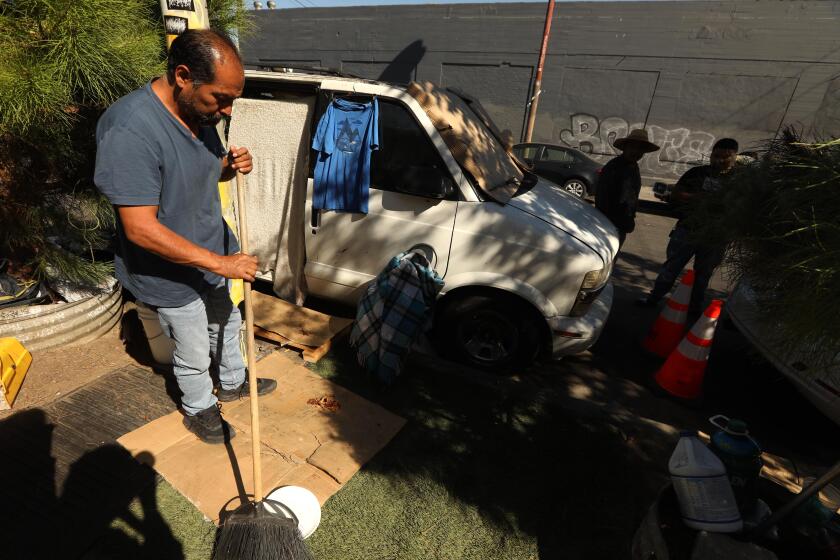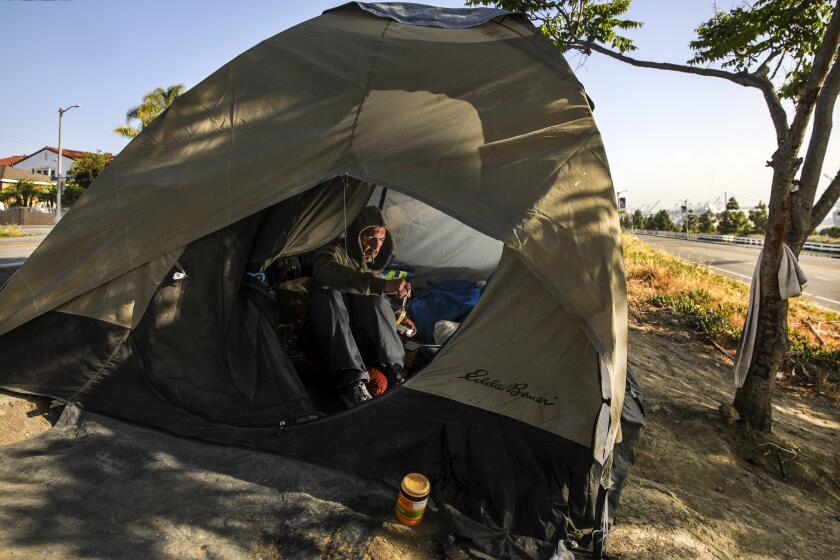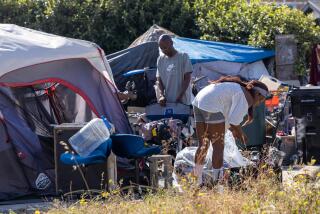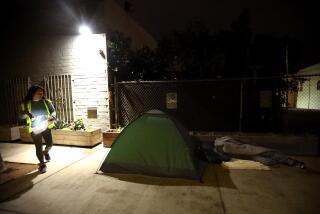Rand survey finds homelessness up 18% in L.A. hot spots where the official count recorded decreases
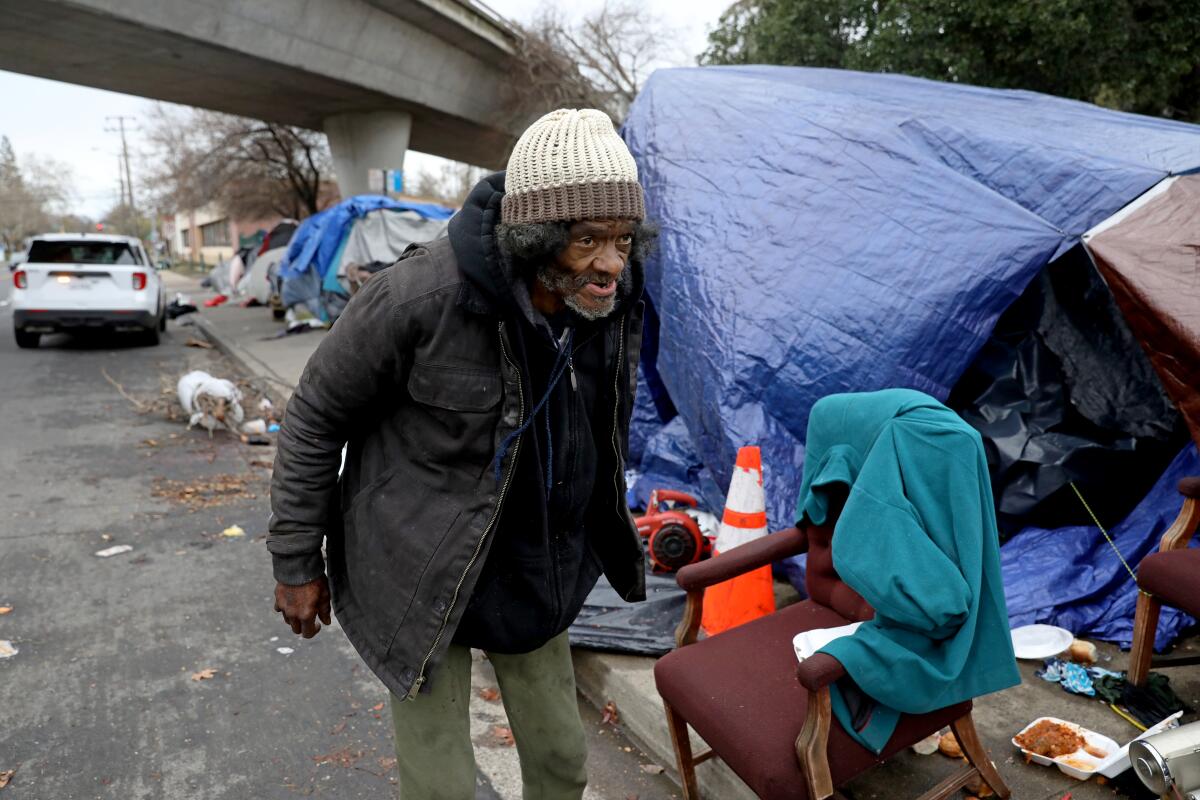
- Share via
In a bit of welcome news that was immediately met with skepticism, the Los Angeles Homeless Services Authority reported last summer that homelessness appeared to be leveling off.
After climbing nearly 23% in two years, the county’s street population grew only an additional 5% during two years of pandemic, the 2022 point-in-time count found, deflecting worries that economic stress would drive large numbers of people from their homes.
Most surprisingly, LAHSA found significant decreases in three communities widely identified as hot spots of homelessness: skid row, Hollywood and Venice.
But a survey released by the Rand Corp. on Thursday casts doubt on those findings. Researchers who zeroed in on those three areas, returning dozens of times over a year, recorded large increases in unsheltered homelessness: 13% in skid row, 14.5% in Hollywood and 32% in Venice, averaging out at 18%.
The Rand study, conducted from September 2021 through October 2022, draws no conclusion on the accuracy of LAHSA’s estimate of the total number of homeless people in Los Angeles County last year, 69,144.
Instead, it makes the case that the annual three-day count (this year’s was held this week and concluded Thursday night) is subject to a gantlet of error — human, technological and statistical — as thousands of volunteers record their observations on cellphones while walking and driving streets across the county. The flaws in this approach, the researchers argue, limit its value as a measure of trends and as a tool in policy decisions.
Citing city actions to clear homeless people from Echo Park and Venice and a court order requiring the city to provide shelters, study author Jason Ward concludes that “these policies and activities were formulated without the aid of any current, high-quality data on the number of people living unsheltered in these areas” or any data about their “specific housing experiences, need and preferences.”
By zeroing in on small areas known to be heavily populated by homeless people and surveying them repeatedly over a year, the $260,000 study gleaned insight that a sprawling one-time count could not.
Homelessness among Latinos has shot up in Los Angeles County while other demographic groups have seen a decline over the last two years.
The study found, for example, that a three-day cleanup that removed tents from Centennial Park in Venice in June was followed by a 13% decline in the next month’s count. The decrease was driven by fewer tents and makeshift shelters, while the number of cars, vans and RVs remained the same. But by later that month, the population had rebounded to its former level.
This type of information would be valuable to public officials weighing policies such as the city’s anti-camping ordinance and new Mayor Karen Bass’ Inside Safe street cleanup program, Ward said in an interview.
“We came up with some interesting evidence on the kind of housing solutions that will work better,” he said.
More than 80% of respondents said they would accept offers of permanent supportive housing, a hotel or motel or a shelter if it offered privacy. Only 30% said they would go into a group shelter and 35% a sober living home. The most common reasons given for resisting shelter were lack of privacy, 40%, and concern over safety, 35%.
But two other forms of housing not widely advocated as solutions to homelessness proved unexpectedly promising. Just under half of respondents said they would live in an apartment or house with other people or in a safe camping site with organized tent spaces.
Many of Rand’s demographic findings were consistent with those LAHSA has perennially reported: The homeless population is predominantly male and disproportionately Black. About half of respondents reported either chronic health conditions or mental health issues or both. People living on the streets are predominantly from Los Angeles County.
But the Rand study found a much higher incidence of chronic homelessness. Nearly 80% told Rand surveyors they had been homeless more than a year and 57% for more than three years. LAHSA’s figure for chronic homelessness — either one year continuously homeless or a year over a three-year span — in the three neighborhoods was about 50%.
“It appears that most of the people living unsheltered in Los Angeles would qualify as chronically homeless on the basis of their current spell of homelessness alone,” the report said.
On a strip of dirt called the Gulch, along Gulch Road in San Pedro, homeless people face a city deadline and an uncertain future.
A detailed comparison of Rand’s findings with LAHSA’s, Ward said, showed a “mixed bag, in some cases remarkably consistent, in others way off.”
In one Venice census tract, LASHA counters recorded more than twice as many RVs as Rand’s but in another, only half as many. The number of individuals counted were close in some Hollywood tracts by wildly different in others.
Ward, who has participated in annual counts, attributes such differences to training.
“To me, the training was 30 minutes on the app, 15 minutes on being safe and a minute and a half on how to identify people in different shelter types,” he said. “You really need to train people how to make these decisions, not just how to use the app and press the right button.”
To ensure accuracy and consistency, Rand’s paid surveyors received three days of training. Two counters worked independently on each block, then averaged their results. Significant discrepancies were rechecked.
In contrast to LAHSA’s study, the Rand report presents its estimates with upper and lower bounds, taking into account a fundamental ambiguity in LAHSA’s counting process: Counters are told to record every individual and every tent or shelter they see, leading to potential double-counting of people who are seen outside their tents or shelters.
Rand’s surveyors asked people where they slept. For its lower estimate, Rand adjusted the individual count downward by the percentage who said they slept in shelters or tents.
Ward refrained from comparing the raw numbers from the two studies simply because the areas his covered were considerably smaller than those LAHSA uses to define the communities and because the official count covered two years. LAHSA canceled the 2021 count because of the COVID-19 pandemic.
But, in an interview, Ward said he felt confident that LAHSA’s count missed the increases his study found. The differences were too great to dismiss.
Publication of the Rand study on the final day of LAHSA’s three-day count for 2023 was largely coincidental, Ward said. The report was ready earlier, but its release was delayed in deference to the official count, which, despite its flaws, he considers valuable.
“We wouldn’t want it to throw cold water on the value of participating in the count,” Ward said.
More to Read
Sign up for Essential California
The most important California stories and recommendations in your inbox every morning.
You may occasionally receive promotional content from the Los Angeles Times.
